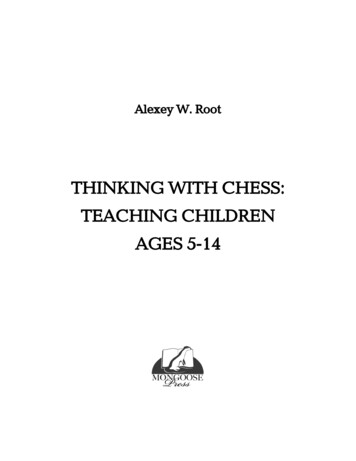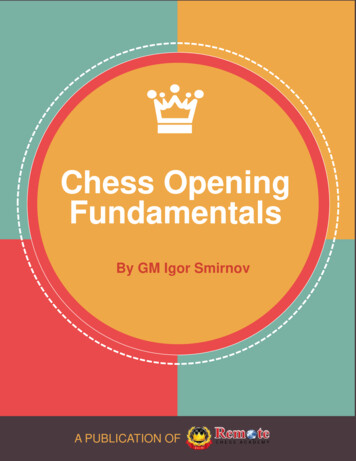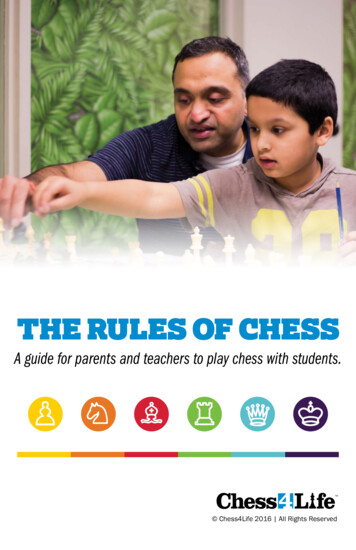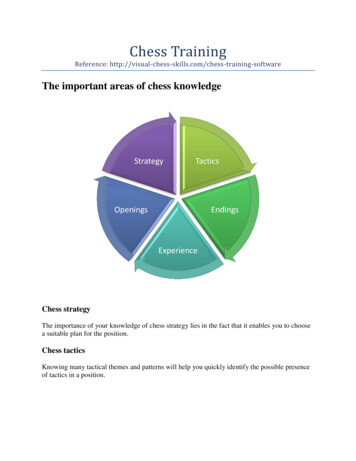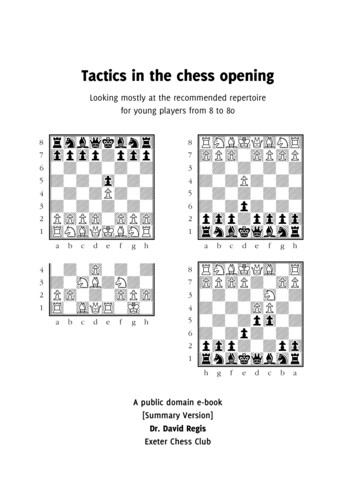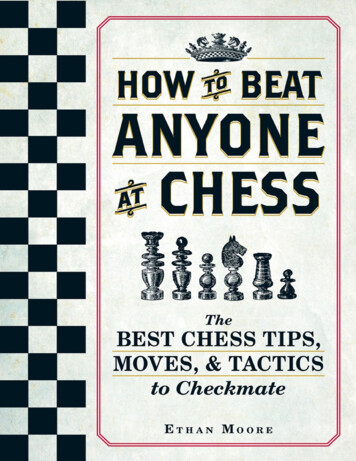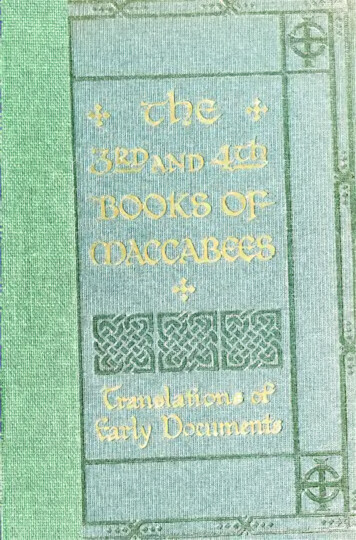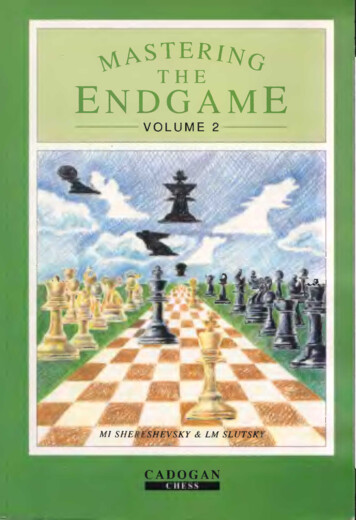
Transcription
CADOGAN CHESS BOOKSMastering the EndgameVolume 2: Closed Games
Cadogan Chess BooksExecutive Editor: PAUL LAMFORDAdviser: MAL COLM PEIN, 1MRussian Series Editor: KEN NEATSome other endgame books:Chess Endings: Essential KnowledgeAverbakhComprehensive Chess EndingsVolume 1: Bishop Endings, Knight EndingsAverbakhVolume2:& ChekhoverBishop against Knight Endings, Rook against Minor Piece EndingsAverbakhVolume3:Queen and Pawn Endings, Queen against Rook Endings,Queen against Minor Piece EndingsAverbakh, Henkin& ChekhoverVolume 4: Pawn EndingsAverbakhVolume5:Averbakh& MaizelisRook Endings& KopayevEndgame StrategyShereshevskyMastering the Endgame, Volume 1Shereshevsky& SlutskyRate Your EndgameMednis& CrouchFor a complete catalogue of Cadogan Chess Books (which includes the formerPergamon and Maxwell Macmillan chess lists), please write to:Cadogan Books, 38 Warren Street, London WIP 5PDTel: 071 388 241 0Fax: 071 388 2407
Mastering the EndgameVolume 2:Closed GamesbyM.I.Shereshevsky & L.M.SlutskyTranslated and Edited byKen NeatCADOGAN,·"ltit1KNIGHTSBRIDGE, LONDON
CADOGAN BOOKSDISTRIBUTIONUK/EUROPE/AUSTRA LASI A/ ASIA/AFRICADistribution: Grantham Book Services Ltd. Isaac Newton Way, AlmaPark Industrial Estate, Grantham, Lincs NG31 9SD. Tel: 0476 67421;Fax: 0476 590223.USA/CANADA/LATIN AMERICA/JAPANDistribution: Macmillan Distribution Center, Front& Brown Streets,Riverside, New Jersey 08075, USA. Tel: (609) 461 6500; Fax: (609) 7649122. 1992 Mikhail Shereshevsky, Leonid SlutskyAll Rights Reserved. No part of this publication may be reproduced, storedin a retrieval system or transmitted in any form or by any means: electronic,electrostatic,magnetic tape,mechanical, photocopying,recording orotherwise, without permission in writing from the publisher.First published 1992Library of Congress Cataloging-in-Publication Data(applied for)British Library Cataloguing in Publication DataA CIP catalogue record for this book is available from the British LibraryISBN 0 08 037784XCover by Pintail DesignPrinted in Great Britain by B PCC Wheatons Ltd, Exeter
ContentsIntroductionDark-Square S trategyVariations with t he Central Exchange dxe5Pawn Wedge in the CentreThe Exchange . exd4Attack on the White Centre with . c52Light-Square Strategy3SymmetryOpen CentreClosed Centre: the E xchange cxd5 cxd5The Exchange dxc54AsymmetryCentral/Kingside Majority against Queenside MajorityMaroczy Bind FormationAndersson (Hedgehog) FormationTransformation of the IsolaniBackward and Hanging PawnsThe Two BishopsThe Catalan BishopIndex of GamesIndex of Openingsvii12385870921 181 181321401491491731 841942072 17227236240
IntroductionWhen working on the second volu me of this book, the authors decided to change theorder in which the material is presented. In games begun with the open and semi-openopenings, the endgame for a long time retains its individuality; thus one does notconfuse a Sicilian endgame with a Ruy Lopez, or a Caro-Kann endgame with one fromPetroffs Defence. I n the closed openings t hings are more complicated. [n many of themidentical pawn structures arise and, for example, openings so dissimilar in spirit as theQueen's Gambit and the Grunfeld Defence can lead to analogous endings.The strategy of systematic pressure, carried out by W hite in the closed openings, canbe opposed by Black with various means of cou nterplay. In principle, all the variousclosed openings can be arbitrarily divided into two parts : in the first Black allows thecreation of a white pawn centre , while in the second he actively prevents this. Methodsused by modern theory in the s truggle wit h the enemy centre include impeding it withpawns (King's I ndian set-ups) and piece pressure ( Grunfeld Defence). B lack can alsooppose the creation of a pawn centre in different ways - ' physically' (Queen's Gambitset-ups) and by piece pressure on the light squares ( Nimzo-Indian, Queen's I ndian andDutch Defences). It was this that led to the plan of t he second volume: to present all thematerial not by opening classification, but in accordance with the strategy of the strugglefor the centre.The reader will rightly notice the relatively large number of 'King' s I ndian' endings,presented in t he ' Dark-Square S trategy' section. The King's Indian Defence occursincreasingly rarely in top-level tournaments. The charm of its novelty has largely beenlost, whereas the degree of risk has grown several-fold. W hite has a wide range ofpossibilities for developing his initiative - from direct play 'for mate' in t he SamischVariation to 'emasculating's set-ups with the exchange on e5 . By including in the booksome King' s I ndian clashes from the 1 950s and 1 960s, the authors wanted to recall thehappy times of the King' s I ndian Defence, w hen it was called 'the main contemporaryopening problem' . ( I n recent years, however, t hanks to the successes of the WorldChampion, there is a justification for talking of another burst in popularity of theKing's I ndian Defence.)The chapters 'Light-Square S trategy', 'Sy mmetry' and 'Asymmetry' are not soextensive, but in our opinion they will give the reader an impression of the link betweenthe chosen opening strategy and the resulting ending.In the closed openings, Black from the very first moves has to solve the problem offighting for the centre . In all the diversity of the closed openings, two basic strategies forBlack can be traced: either he allows the formation of an enemy pawn centre, or else hedoes everything possible t o prevent it. In the first case, exploiting the time spent byWhite on the formation of his centre, Black strikes a blow at the weakest point - the d4
viiiIntroductionpawn - by . . . e5 or . . c5, with subsequent play on the dark squares . This has been giventhe name of dark-square strategy.[n practice the second path can be carried out in two wa y s : by the classical blocking ofthe d4 pawn ( 1 d4 d 5 2 c4 e6), or by piece pressure on the light squares ( 1 d4 tDf6 2 c4 e63 tDc3 iLb4, or 3 tDf3 b6 etc). This latter example typifies light-square strategy.Translator's NoteTo reduce the o riginal manuscript to a manageable size for publication, severalgames have had to be omitted. W here they are readily available in ot her books currentlyin print, this has been i ndicated in the text - it is recommended that these games bestudied in conjuction with the appropriate chapter.
1Dark-Square StrategyDark-square strategy is mainly repre sented by I ndian (i.e. King's I ndian andBenoni) set-ups, which in recent timeshave occurred rather rarely in top- leveltournaments. There are many reasons forthis, the main one being W hite's advantagein space. But the possession of more spacedemands additio nal care in m aintainingit, and in the resulting complex positionsa slight inaccuracy by W h ite will allowthe opponent to develop a dangerouscounterattack. Indian set-ups have broughta nu mber of striking victories to playerssuch as Boleslavsky, B ronstein, Geller,Tal, Gligoric, Stein, Fischer and Kasparov.Black usually aims to realise his cou nter chances in the middlegame , since withsimplificatio n W hite's spatial advantagebecomes increasingly perceptible. Thisdoes not mean t hat any I ndian ending isbad for Black, but in general Whit e'sprospects are more favourable.23Black' s cou nterblow against t he d4pawn by . . . e5 or . . . c5 can lead topositio ns with various pawn structures.In reply to . . . e5 (or . . . c5) White canchoose three different methods of play: hecan advance his d-pawn, exchange on e5(c5), or maintain the tension in the centre.These are schematically depicted in thethree diagrams above.
2Mastering the Endgame IIU sually B l ack is not able to maintainthe central tension for long, and then t heexchange . . . exd4 leads to the followingpawn formation:Positions with the exchange dxc5 areconsidered in the 'Sym metry' section, andthose with the exchange . . . cxd4 u nder t he'Maroczy Bind' .1.1VARIATIONS WITH THECENTRAL EXCHANGE dxe5Any player choosing King' s I ndian set ups as Black must be able to handlecompetently the endings arising after thecentral exchange dxe5 followed by t heexchange of queens. There are a numberof masters who as White often solve inthis way the problem of the King's I ndianDefence, especially since in many openingpositions dxe5 is the best m ove.By what is White guided when hechooses the 'unpretentious' exchange inthe centre? After all, the drawbacks hereare patently obvious. B ack in the 1 930s itwas observed that the exchange of queenson the 5th move ( after 1 d4 liJf6 2 c4 d6 3*Cf. Smyslov'sliJc3 e5 4 dxe5 dxe5) does not bring Whiteany advantage . "The e5 pawn", it wassaid then, "is stronger than the c4 pawn" .The exchange dxe5 looks even more strangein the Classical Variation (after 1 d4 liJf62 c4 g6 3 liJc3 i. g7 4 e4 d6 5 liJf3 0-0 6 ii.e2e5 7 dxe5 dxe5), irreparably weakeningthe d4 square. And yet this is played, andquite often . There are several reasons .Firstly, after the exchange in the centreWhite normally gains one or two tempifor the development of his pieces, forexample: 1 d4 liJf6 2 c4 d6 3 liJc3 e5 4 dxe5dxe5 5 'tWxd8 'it xd8 6 liJf3 liJfd7 (interes ting here is the idea of the S oviet masterChebanenko: 6 . . . liJc6!? 7 liJg5 'it e 7! ) 7b3, or 1 d4 liJf6 2 c4 g6 3 liJc3 iLg7 4 e4 d65 liJf3 0-0 6 .lte2 e5 7 dxe5 dxe5 8 'tWxd8lI xd8 9 ii.g5 I1e8 1 0 0-0-0, or 1 d4 g6 2 c4d6 3 liJc3 iLg7 4 liJf3 e5 5 dxe5 dxe5 6'tWxd8 'it xd8 7 ii.g5 f6 8 0-0-0 .Secondly, White can remove the oppo nent's pressure on d4 by the simple moveliJ c3-d5, after which the exchange . . .liJ xd 5 , cxd5 , positionally favourable toWhite, is usually forced.Thirdly, the exchange dxe5 is not withoutits psychological implications. The King'sIndian Defence is usually chosen by playersof aggressive style, who prefer complicatedplay with many pieces on the board, andhave a certain dislike for 'simple' positions.Thus the central exchange dxe5 pre determines the plans for the two sides inthe resulting ending:For White - active piece play, to preventthe opponent from exploiting the weaknessof the d4 square. By pressure on t he d-fileWhite aims to force . . . c6 and to becomeestablished on the important d6 square(preferably, in combination with themove c4-c5), as in the game S myslov Polugayevsky (Palma de Mallorca 1 970).*125 Selected Games p.186 (Pergamon, 1983).
3Dark-Square StrategyHe may be able to exploit the passedpawn at d5, created as a result of pieceexchanges on this square ( cf. Botvinnik Tal), or occupy d5 or b5 with his bishop,followed by exchanging it for a knight atc6 and 'working on' the resulting queensideweaknesses (Larsen-Hubner). To takeaccount of all the diversity of plans is notpossible, but the basic theme of White'splay - rapid mobilisation, control of t hecentre, attack on the queenside - is clear.Black's strategy is to neutralise t hepressure and t o exchange the opponent'sactive pieces, especially the dark-squarebishop (cf. the games Flohr-Geller, Larsen Fischer and Berger-Gligoric), followedby exploiting the opponent's dark-squareweaknesses in the centre (d4 ! ) and on t hequeenside.It is obvious that a ' clash of interests' ofthe two sides is inevitable, and the exchangedxe5 promises play which is no lessinteresting than after the other thematicKing' s I ndian m oves: d4-d5 and . . . e5xd4 .Botvinnik-TalWorld Championship M atch ( 1 3)M oscow 1 9 6 1King's Indian DefenceI d4 lbf6 2 c4 g6 3 lb c3 i. g7 4 e4 d6 5 f30-0 6 i.e3 e5 7 dxe5The Samisch Variatio n was always aformidable weapon in B otvinnik's hands;his victories became renowned, while hisdefeats were very rare and in them hisopening strategy was least to blame.Botvinnik would usually 'drive in a wedge'with 7 d5 , and then mercilessly squeezeBlack in the centre and on the kingside(memorable, for example , is the 2 1 st ,concluding game from the same matchwith Tal). His decision to exchange queenswas therefore due to psychological factorsand was dictated mainly by match tactics:" . . . after winning the 1 2t h game, Tal wasin an aggressive mood, as indicated by hischoice of opening. Taking account ofthis, White correctly decides that first andforemost he must exchange queens"(Botvinnik).78 'HYxd8dxe5E:xd8 (5)9 lbd5lb xd55H ere, in contrast to the Classical Vari ation, t he e4 pawn is defended (comparethe game Ivkov-Tal, p. 1 3), and the exchangeon d5 is the most advisable. 'Tal-style'play could have ended dismally: 9lb e8? ! 1 0 0-0-0 E:d7 1 1 i.d3 c6 1 2 lbc3lb a6 1 3 a3 lbec7 14 lbge2 lbe6 1 5 i.c2lb ac5 1 6 l:ixd7 lbxd7 1 7 l:id l i.f8 1 8 b4!a5 1 9 c5 , and B lack is thoroughly cramped(Sokolov-Janosevic, Belgrade 1 96 1 ).1 0 cxd51 1 i. c4c6b5Tal i s not satisfied with the simple path,known since the game Boleslavsky-Najdorf(Zurich Candidates 1953): 1 1 . . . cxd5 1 2i.xd5 lb c6 , and h e tries to seize theinitiative on t he queenside . M eanwhile, asl ater shown by Geller, here Black canperfectly well count on good play: 1 3
4Mastering the Endgame II0-0-0 ltJd4 ! 1 4 i.xd4 exd4 1 5 ltJe2 i.f5 !(Calero-G eller, H avana 1 963), and aftermissing the chance to equalise by 1 6i.xb7 ! , within a few moves White endedup in a desperate situation: 1 6 Wd2? llac81 7 llc I i.h6 ! 1 8 f4 llxc I 19 ltJ xc I ( 1 9llxcl d3! ) 1 9 . . . .txf4 .1213i.b30-0-0.tb713 llcI would have been more dangerousfor B lack, when after 1 3 . . . cxd5? 1 4 llc7lld7 15 llxb7 ! White wins. 13 . . . lld7? ! 1 4ltJe2 cxd5 1 5 i.xd5 ltJ a6 1 6 i.xb7 llxb717 ltJc3 is also not good for Black (Perez Gligoric, H avana 1 962), but 1 3 . . . a5! ,fou nd by Boleslavsky, solves all his prob lems. " White is less well developed thanhis opponent", wrote Boleslavsky, "andwishes to gain an advantage by tactics .Such play is positionally unj ustified, andBlack must be able to find a sufficientantidote" . From the interesting analysisof this outstanding grandm aster we giveone of t he variations : 14 a4 bxa4! 1 5i.xa4 (if 1 5 i.a2? then
For a complete catalogue of Cadogan Chess Books (which includes the former Pergamon and Maxwell Macmillan chess lists), please write to: Cadogan Books, 38 Warren Street, London WIP 5PD Tel: 071 388 2410 Fax: 071 388 2407 . Mastering the Endgame Volume 2: Closed Games by M.I.Shereshevsky & L.M.Slutsky Translated and Edited by Ken Neat CADOGAN ,·"ltit1 KNIGHTSBRIDGE, LONDON . CADOGAN BOOKS .
